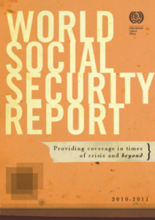This report from the International Labor Organization is the first in a series of the World Social Security Reports whose chief aim is to provide the results of regular statistical monitoring of the state and developments of social security in the world. It presents the knowledge available on social security coverage in different parts of the world, identifies existing coverage gaps and examines the scale of countries’ investments in social security. Finally, it focuses on social security responses in the context of the economic crisis. Although social security is a human right, only a minority of the world’s population actually enjoys that right, while the majority lacks comprehensive and adequate coverage. More than half lack any type of protection at all. In Sub-Saharan Africa and South Asia, the number of people with access to even the most rudimentary protection is estimated to be less than 10 per cent. The report reiterates ILO’s main request to countries to develop “adequate social security for all, drawing on a basic social protection floor including access to health care, income security for the elderly and persons with disabilities, child benefits and income security combined with public employment guarantee schemes.” The report is a useful tool for who design, implement, manage, administrate, or defend social security systems.
Social Security is defined in this report as “all measures providing benefits, whether in cash or in kind, to secure protection, inter alia, from (a) lack of work-related income (or insufficient income) caused by sickness, disability, maternity, employment injury, unemployment, old age, or death of a family member; (b) lack of access or unaffordable access to health care; (c) insufficient family support, particularly for children and adult dependants; and (d) general poverty and social exclusion. As such, social security can play a critical role in strengthening the capacity of vulnerable families to care for their children and prevent harmful separation, including through the provision of child and family benefits, access to maternal health services and paid maternity leave, but also basic income support to older and disabled care givers. As part of this comprehensive review, the authors note serious imbalances in the allocation of resources to social security in countries with lower incomes, high poverty rates and large informal economies. Not only are the resources allocated low but in addition the structure of expenditures does not match obvious patterns of social priorities. In particular, near negligible resources were allocated to income support measures such as cash benefits to families and children, to those unemployed or the poor, while contributory social security schemes dominate although they cover only a minority of the population in those countries. In the context of its campaign to extend social security to all, the ILO is promoting a social security floor that sets out essential social guarantees which includes that all countries ensure their children have income security, at least at the nationally defined poverty level, through family or child benefits aimed at facilitating access to nutrition, education, and care.

